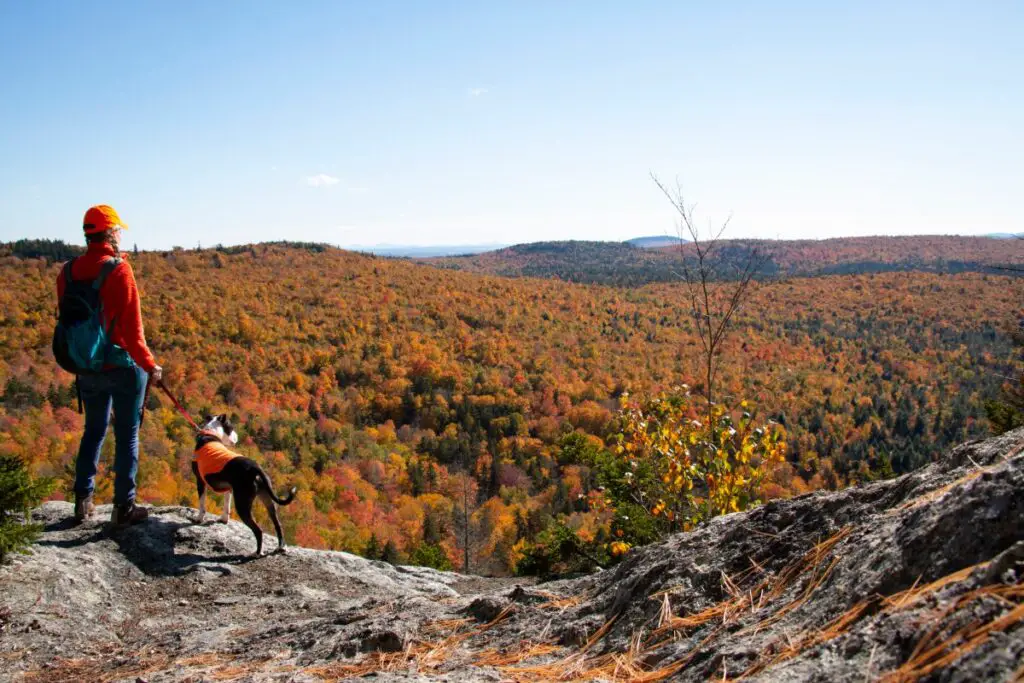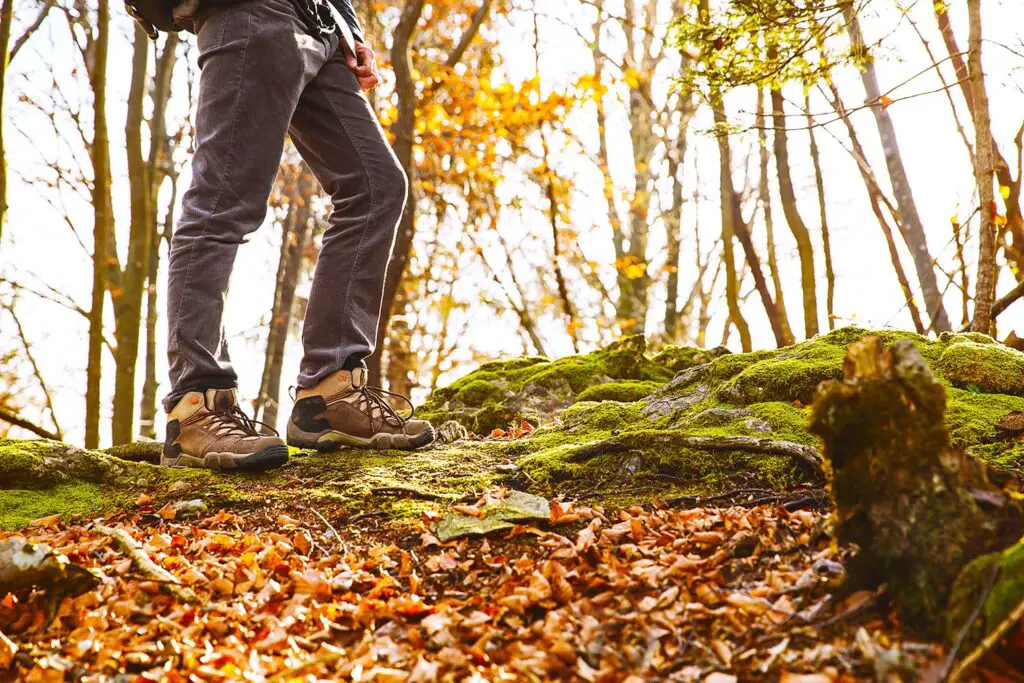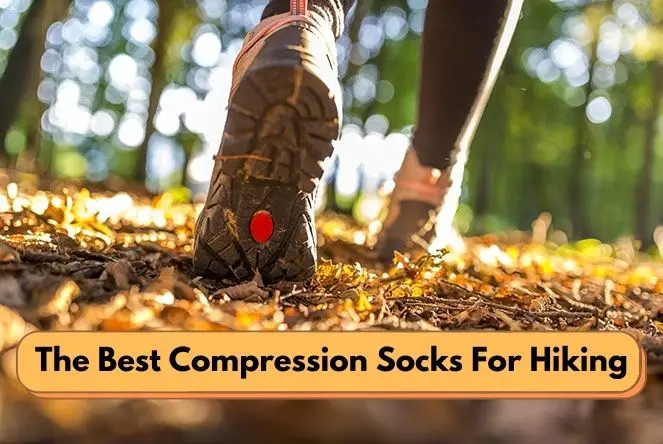Using compression socks for hiking can greatly improve the quality and comfort of your hikes by reducing swelling, preventing blisters, and reducing foot fatigue.
By switching out your regular socks for compression socks, you’ll be stimulating blood flow and providing extra support and protection where it’s most needed.
In this guide, we’ll go through our top picks for the best compression socks for hiking, along with a guide on the benefits of compression socks and what to look for when making your selection.
The Best Compression Socks For Hiking – Quick Reference
| Best Compression Hiking Socks for Preventing Blisters | Injinji Ultra Compression OTC Socks |
| Best Compression Hiking Socks On A Budget | Wanderlust Knee-High Merino Compression Socks |
| Best Overall Value Compression Hiking Socks | Sockwell Circulator Moderate Graduated Compression Socks |
| Best Cold Weather Compression Hiking Socks | MudGear Premium Compression Socks |
| Best High-Compression Hiking Socks | CEP Tall Athletic Compression Socks |
The Best Compression Socks For Hiking – Our Top Picks
Injinji Ultra Compression OTC Sock

The Injini Ultra Compression OTC Sock is a lightweight graduated compression sock that is excellent for preventing blistering and provides much-needed arch support.
These socks incorporate separate toe sleeves to promote proper alignment and separation, which minimizes friction and reduces the chances for blisters.
They’re 20% lycra and 80% nylon, so they’re quick-drying and moisture-wicking. The bands on the lower of the sock provide arch support, and the mesh top is breathable to keep your skin and legs cool during use.
These compression socks are great for multiple uses, such as running and hiking, and won’t slip after a day of long use.
Why We Like It:
-Great breathability and moisture-wicking properties
-Arch support included
-Five toe style prevents blistering and cuts down on sweating
-Materials allow them to stay in place for long periods of use while still feeling comfortable
Wanderlust Knee-High Merino Compression Socks

The Wanderlust Knee-High Merino Compression Socks are a great first-time choice, as they provide many benefits while also being extremely affordable.
These socks are comfortable, being made of 9% merino wool, 8% polyester, 10% lycra, 33% nylon, and 40% acrylic. Each material has its own benefits, and this blend ensures the socks are comfortable, durable, and breathable all at once.
They feature a gradient medical-grade compression design, putting the proper amount of pressure where it’s needed on each part of your foot and leg to optimize performance.
These socks offer 25-30 mmHg at the ankle, 15-20 mmHg at the middle calf, and 10-15 mmHg just below the knee.
Why We Like It:
-Graduated compression puts pressure where you need it most
-Simple design
-Affordable and very comfortable
-Cushioned sole provides extra padding
Sockwell Circulator Moderate Graduated Compression Socks

The Sockwell Circulator Graduated Compression sock is a high-performing sock that packs lots of value in at a fraction of the price of similar socks available.
These socks feature 4 zones of moderate 15-20 mmHg graduated compression, helping to sooth and energize tired feet and legs, and helps to minimize swelling and reduce fatigue.
They’re made up of 32% merino wool, 32% nylon, 31% rayon, and 5% spandex. This blend offers and excellent balance of durability, comfort, breathability, and compression.
Why We Like It:
-Lightweight and cushiony
-Wool/nylon blend makes these socks durable yet warm and breathable
-Odor-resistant
-Good moisture-wicking properties
MudGear Premium Compression Socks

These MudGear Premium Compression Socks were originally designed to withstand harsh outdoor conditions like Spartan Race and Tough Mudder, so you know they’re big on durability and action.
They offer moderate graduated compression, ranging from 15-20 mmHg, with the highest pressure at the ankle and the lowest at the knee.
The 63% nylon, 28% polyester, and 9% spandex blend offers outstanding moisture-wicking properties to help keep your feet dry and blister-free, while the added insulation and padding help to keep your feet and calves warm and protected.
These socks are also made in the USA and are backed by both a lifetime warranty and 100% satisfaction guarantee.
Why We Like It:
-Highly durable
-Graduated compression features
-Extra padding in calf area is a nice touch
-Well-insulated for cold hikes
-Backed by a lifetime warranty and 100% satisfaction guarantee
CEP Tall Athletic Compression Socks

CEP’s Tall Athletic Compression Socks are a good mid-range budget option that offers the pressure rating of a medical-grade sock while still being comfortable enough to hike in.
These socks offer 20-30 mmHg of graduated compression, offering great support to the ankle and calf and relaxing the pressure a bit near the knees.
These socks mold to your feet without restricting the toes, resulting in a better boot or shoe fit while reducing blisters.
The halo top-band helps to keep the socks in place even after hours or miles of use, and the front ribbing allows the air to cool as it flows through to the surface of the skin, keeping your legs cool.
Why We Like It:
-Higher compression rating than other socks available
-Great at regulating temperature
-Highly comfortable
-Affordable price point

Compression Socks For Hiking – Buyer’s Guide
What Are Compression Socks For Hiking?
Compression socks that maintain a stretchy quality while also being tight around the foot and leg.
While this may not sound appealing at first, they’re great at promoting blood flow, reducing muscle fatigue, and reducing swelling during your hikes.
Let’s explore some of the benefits of compression socks in further detail below.
Benefits Of Hiking Compression Socks
Compression Socks Increase Blood Flow When Hiking
If you’re standing, hiking, or doing anything on your feet for long periods of time, blood can sometimes have more trouble pumping back up towards your heart.
Compression socks help to bring your blood flow from your extremities back to your heart, and increasing that blood flow helps areas of your body that are most prone to injuries – like your fascia and Achilles tendon.
Compression socks also help to reduce blood clotting.
Compression Socks Reduce Hiking Blisters
These socks fit snugly on your feet, eliminating the sock-to-skin friction that causes blisters.
They’re also moisture-wicking, so they move sweat away from your skin, reducing the bunching of fabric and formation of blisters.
Compression Socks Reduce Swelling Caused By Hiking
Tendonitis and plantar fasciitis can cause swelling in the foot, ankle, and lower calf. Using compression socks helps to prevent blood from swelling in these areas and also relieves the pain associated with swelling.
Different Types Of Compression Hiking Socks
Graduated Compression Socks
Graduated compression socks apply precise amounts of pressure to different parts of the leg in order to constrict the veins and increase the velocity of blood flow through your veins.
Graduated compression socks are better than uniform compression socks for activities like hiking for relieving pain and reducing swelling.
Compression Sleeves
These are essentially compression socks without the part that covers your foot.
Use compression sleeves if you have sweaty feet or if you prefer the feel of them over regular compression socks.
How To Find The Right Size Compression Socks For Hiking
Look for a snug but not overly tight fit when choosing your compression socks. Be sure the heel cup of the sock lines up exactly with the heel of your foot.
Buy socks sized to your foot rather than your boot or shoe when selecting a sock size. Try a size up if you like, but be sure there is not any extra material that can bunch up in your boot, as this can cause blisters.
Choose The Right Compression Rating Number On Your Hiking Socks
The most important measurement to look for when choosing compression socks for hiking is the mmHg rating (or millimeters of mercury rating), which represents the amount of pressure a compression sock provides.
The higher the number, the more compression is placed.
For example, a 15-20 mmHg compression sock would provide 20mmHg of compression at the ankle and 15mmHg of compression at the calf.
Less than 15 mmHg will provide light pressure, while 15-25 mmHg will provide moderate pressure. Over 22mHg is considered medical grade and are available on a prescription-only basis.
Select The Best Hiking Compression Sock Materials
Most compression socks offer blends of natural fibers like merino wool or bamboo and blend them with synthetic fibers like spandex, polyester, or nylon.
Both merino wool and bamboo are breathable, quick-drying, and comfortable.
Nylon, polyester, and spandex help to add durability and to help your socks keep their shape.
The best compression socks for hiking will blend natural and synthetic fibers.
Compression socks that are higher on natural fibers will be more breathable and odor resistant, while those with higher concentrations of synthetic fibers will be more durable and provide higher performance.
Pick The Right Warmth & Wicking Compression Socks For Your Hiking Needs
If you’ll be hiking in wet or cold conditions, then choose compression socks that have incorporate wool fibers in them, as they are best at insulation and moisture-wicking.
Find The Right Style And Cut Of Compression Socks For Hiking
Compression socks are great, but you need to choose the right fit for your activity and preference.
Compression socks are tight by nature, so it may be wise to choose a size up when starting out, which will help to ensure you’re not cutting off circulation.
Don’t go too big on sizing though, as that will cause fabric bunching and can increase your chance of blisters due to increased friction.
Hiking compression socks can come in low-cut models that offer mostly ankle and lower calf support, or all the way up to knee-cut, which provide full shin and calf support.
Some compression socks also incorporate cushioned soles, adding additional arch support and comfort. If you’re flat-footed, you should definitely opt for a compression sock that includes a cushioned sole with arch support.
Wrapping Up The Best Compression Socks For Hiking

We hope you’ve learned a lot and that this guide helped you to make the best selection of hiking compression socks for your situation.
What did you decide on? Let us know in the comments below!
While you’re here, be sure to check out our guide to how hiking boots should fit, as well as our top picks for the best men’s hiking boots under $100 and best women’s hiking boots under $100.

